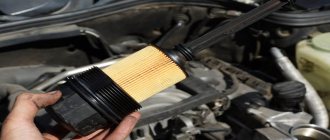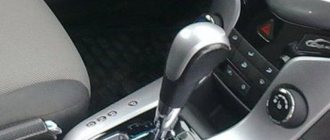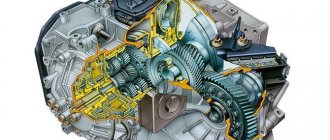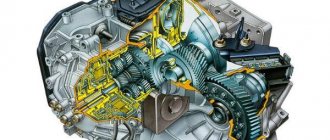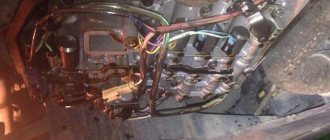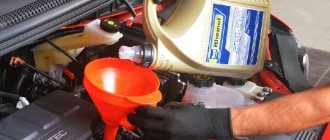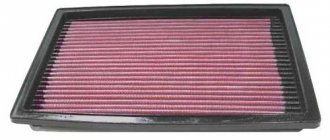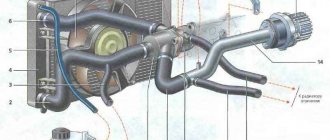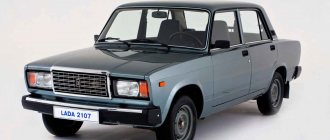The lifespan of a Kia Rio car depends on many factors - make and model, frequency of use, roads on which it travels and care for it. Let's talk about the latter in more detail, because not only how long your iron horse will last, but also the comfort of the driver depends on it. Lubricants play an important role in the performance of a car, so you shouldn’t delay replacing them if the need arises. How to change the oil in a Kia Rio engine on your own and by what parameters do you know if it’s time? This is what we will talk about today.
Manufacturer's recommendations for changing oil
The oil change in the engine of the new Kia Rio is carried out after the first 3000 km. This is the established break-in procedure. Until the first 3000 km have been covered, it is not recommended to load the power apparatus with maximum speeds and weight loads. It is best to move along straight sections of the road at a speed of 80–90 km or at engine speeds within 2–4 thousand.
A similar procedure should be carried out after an engine overhaul. The shortening of the Lada Granta oil change interval in new and repaired engines is motivated by the fact that the grinding process of parts produces the appearance of various particles. It is better to remove them along with the lubricant so as not to cause harm to the power unit.
In all other cases, the oil change on the Kia Rio is carried out within the scheduled time intervals of 10,000–15,000 km.
During this period, the lubricant maintains the necessary conditions and provides a reliable film coating of all engine components. Beyond these periods, the oil becomes considerably black, liquefies, and loses its viscosity properties.
The quality level of the lubricant also decreases depending on calendar dates. Oil is not wine, and aging does not benefit it. Therefore, regardless of the car’s mileage, the engine lubricant is replaced once a year.
Automatic transmission oil
Original Kia transmission oil guarantees excellent lubricating properties, thanks to which automatic transmission parts will last a little longer.
The manufacturer advises choosing ATF SP-III transmission fluid for this task. Its use will have a beneficial effect on the frequency of oil changes. As an analogue, which also corresponds to the technical characteristics of the Kia Rio car, there is a liquid marked SP-3. It can be considered original; many factory conveyors use it as a lubricant. Among the more affordable analogues that have received a certificate of approval from the Hyundai and Kia brands are lubricants from companies such as ZIC, Aisin and Chevron.
Choosing engine oil and filter
If a motorist wants to do everything correctly, he must know not only the rules for choosing a lubricant, but also how much oil should be in the Kia Rio engine according to the recommendations of the vehicle manufacturer. As a rule, the Russian market offers a huge number of liquids that are ideal for the engine of a foreign car, but you should choose the lubricant that meets the general operating conditions of the car. In any case, the lubricating fluid must belong to the SJ or SL groups, and have an API classification.
When independently choosing engine oil for a Kia Rio, a car enthusiast must take into account several important characteristics, in particular, fluid viscosity, classification group, brand, and manufacturer. In addition, it is necessary to take into account the manufacturer’s recommendations and the temperature range of the substance.
Search for materials
When choosing a Kia Rio engine oil and filter, you should take into account the requirements and recommendations of the car manufacturer. In our case it is Shell Helix Ultra or ILSAC GF-4. The main thing in the characteristics is viscosity. For Kia Rio they recommend 5W-40. Thus, various brands are allowed, including less expensive ones, but subject to this parameter. When using another oil for the first time, the replacement must be carried out with the obligatory flushing of the engine with a special composition.
For Kia Rio there is an original oil filter on sale, but there are also many analogues. Considering the importance of this element in the engine lubrication system, only the original can be recommended.
The operating principle of the device is to collect abrasive particles and impurities that are formed during the operation of a car engine. Filtration is carried out using full-flow and bypass cycles. In the first case, the oil is directed in full to pass through the filter element, the valve adjusted to a certain pressure is closed. When excess pressure appears, in order to avoid “starvation” of the engine’s lubrication, it opens and part of it enters the “engine” without cleaning. Thus, the transition to the bypass cycle occurs. This is possible in case of increased oil viscosity on a cold engine or if the timing of its replacement is violated. The filter component is made of special paper that does not lose its characteristics at high temperatures.
Step-by-step instructions for changing engine oil in a Kia Rio
In order to change the engine oil on a Kia Rio, we will need the following:
- Engine oil - 4 liters.
- Oil filter - code 26300 35503N.
- Drain plug with O-ring - code 21513-23001
- A “17” wrench for twisting the drain plug.
- A syringe with a tube for pumping out residual oil in the oil pan.
- Container for draining used oil
- Flushing oil 3 liters (when changing oil type).
It is advisable to change the oil on an overpass or “inspection hole”, since the drain hole is located under the machine
The procedure itself will include the following steps:
- Place the car on an overpass or “inspection hole”.
- Lift the hood and unscrew the engine oil filler cap.
- Place the car on an overpass or “inspection hole”.
- Lift the hood and unscrew the engine oil filler cap.
- Place the drain container and finally unscrew the plug with your hands.
- Unscrew the oil filter(Proceed with caution as the engine is hot). If the filter does not work, find a special wrench or any other device with a similar operating principle.
- If the car is not new and you do not know what oil the previous owner used, it is recommended to perform an engine flush. To do this, after draining the oil, unscrew the filter and pour out the old oil from it, then screw it into place, tighten the drain plug and fill in the “flushing” oil. Then start the engine and let it run for 10-15 minutes, then drain the “flushing”.
- Using a syringe with a tube, pump out the remaining oil from the bottom of the crankcase (due to the fact that the drain hole is not located at the bottom of the pan, “waste” oil accumulates there).
- Screw in the drain plug (make sure the O-ring is not damaged).
- Before screwing in the oil filter, apply a thin layer of oil to the rubber O-ring and also fill the filter with 2/3 of fresh oil.
- With the drain plug in place and the oil filter installed, pour fresh oil through the oil filler neck .
- Check the oil level with a dipstick; it should be above o and below o.
- Start the engine and wait until the red light with the image of an oil can goes out on the dashboard.
- Stop the engine and check the oil level again. Top up if necessary, but remember that the oil level on the dipstick should be a few millimeters below o.
- On the same day after the trip, it is advisable to check whether oil leaks have appeared from under the oil filter or drain plug. If necessary, tighten them.
For an oil filter, tightening by hand without using any tools is sufficient.
Let's start work
To start work, you need to drive the car into a pit or overpass, otherwise getting to the drain hole will be problematic. We warm up the engine to operating temperature, this is necessary so that the oil becomes liquid and completely flows out of the crankcase. Then we dismantle the crankcase protection; it is usually secured with five bolts.
Then carefully unscrew the drain plug. Try not to tear off the edges if it is tightened too tightly; the crankcase plugs on the Rio are made of soft metal.
Advantages
Doing the work yourself provides a number of advantages.
This allows you to save money on service station services and thus reduce maintenance costs.
Note. The price of work at the station increases if there is protection and the need to dismantle it.
It also gives you the opportunity to work on the car yourself, which many owners enjoy.
And finally, having done everything himself, the owner of the car can be sure that everything is done as needed and not worry about the quality of the work.
Oil filter pullers
There are many design options. I will give only one type, called a cup. Cheap and easy to use. We have two sizes of filters, each with its own separate puller. Below are the articles and sizes.
Puller - cup
For motor 1.4 number 113171. Size 67 diameter, 14 number of edges.
Oil filter puller 1.4l
For motor 1.6 number 113168. Size 78 diameter, 15 number of edges.
Oil filter puller 1.6l
You can purchase it at any large online auto parts store. However, there is a point: when you enter the number into the search, you will most likely be asked to select a manufacturer. Here you need to select everyone in turn, because... Prices under different brands may vary significantly.
The most interesting thing is, no matter which manufacturer you choose, the puller is the same everywhere. That is, they are simply repackers.
Oil Puller Manufacturers
In the image, the green frame marks the campaigns offering the puller. Please note that the sample included a brake drum and some pipes. The search in stores is designed in such a way that it searches for all matches of the article in the database. If there are a lot of them, it is suggested to check with the manufacturer to avoid buying the wrong thing.
Model history, configuration
KIA Rio is a compact family car with front-wheel drive. Designed by the South Korean company KIA, this car has been traveling on the roads of the planet since 2000. A total of 3 generations of cars were produced. The first was from 2000 to 2005, and by the beginning of 2004 the car had undergone a major restyling. Then they were assembled in Kaliningrad, equipped with a 1.5-liter engine; a wider range of engines was offered for Europe. You could choose a gearbox - manual or automatic. There were also two body styles - sedan and hatchback.
The second generation was sold from 2005 to 2009. For Russian car enthusiasts, sedans and hatchbacks were assembled only with a 1.4 liter engine. For European consumers, the KIA Rio offered a choice of 3 engines from the previous generation of cars. Since 2006, cars began to be assembled at the Izhevsk Automobile Plant. By 2009, the model was again restyled and was produced updated until the beginning of 2011. In addition to Russia, production was launched in Slovakia, China, Indonesia, Ecuador and the Philippines.
The third generation saw the world by 2011. The exterior has changed dramatically, becoming modern and aggressive - all thanks to the famous German designer Peter Schreyer. Since that time, the assembly was moved to the St. Petersburg plant. To this day, the car is produced in hatchback and sedan bodies. There are two engine options for the KIA Rio - 1.4 and 1.6 liters. There are also two gearboxes - manual and automatic. The car has the same platform as the Hyundai Solaris. In addition, most of the parts of these cars are unified, which makes their assembly easier and cheaper. In 2014, the car underwent a slight restyling of its appearance.
Possible consequences of untimely replacement
Let's consider the possible negative consequences that will not take long to occur if you do not change the oil on time. Let's start with the least dangerous ones and then move upward.
- Reduced environmental performance of the car. In this case, more active destruction of the catalytic converter occurs. Burning grease creates particles that clog the catalyst and lead to accelerated wear.
- More intensive wear of engine parts. Degrading oil performs its functions less and less. The protective film becomes less stable and is easier to squeeze out from the surface of the mating surfaces, and the lubrication characteristics decrease. Oil performs worse anti-carbon and cleaning functions. Under these conditions, the rubbing surfaces begin to wear out more intensely.
- Possible local overheating of parts. Oil also performs one of the important functions of removing heat from surfaces heated to high temperatures. The presence of foreign impurities in the lubricant reduces its heat-conducting properties. And where good oil would remove the temperature and mix with the bulk without consequences, worn-out oil will simply burn with the formation of soot.
- Interruptions in the supply of decomposed lubricant by the oil pump to the working surfaces. In this case, the connecting rod and main bearings can be destroyed in a short time. This is fraught with jamming of the motor with all the ensuing consequences. Also, heavily used oil can completely freeze into an unpumpable mass in winter, which can also lead to engine seizure.
In general, the trend is as follows: the more oil is used beyond the specified period, the higher the likelihood of critical engine damage.
Original oil filters
On the Kia Rio 3, the filter was the same size and was used on both engines. On the fourth generation, each engine has its own filter.
Original article number ICE 1.4 26300-02503.
Engine filter article 1.4
Engine oil filter 1.4
Original article number ICE 1.6 26300-35505.
Engine filter article 1.6
Engine oil filter 1.6
The original may have a MANN or DONGYANG filter. These companies are traditionally suppliers to Hyundai-Kia. You can identify the company by the markings on the case.
MANN filter
DONGYANG filter
In addition to the markings on the body, information about the supplier is present at the base of the filter, where there is one of two letters M (MANN) or Y (DONGYANG).
When purchasing, always pay attention to the shape of the filter and check the article number. It happens that sellers forget about the difference and give the wrong thing.
Please note, the oil filter on the left is for 1.4l. It is slightly smaller in outer diameter and towards the top has a more pronounced stamp for the puller.
It is worth adding that you can find another type of original filter from the PRODUCT LINE 2 series in gray packaging. In some spare parts catalogs they appear as originals, although they are not listed in the main catalogue.
If you add the letter S in front of the original number, you get an article number. We get for 1.4 S26300-02503, for 1.6 S26300-35505.
They have their own characteristics: the plus is the absence of counterfeit goods. For many years I have never seen a fake. A conditional disadvantage is the slightly smaller amount of filter paper. But if you change the oil at shortened intervals, then this will not become critical.
The price of such filters is usually lower. Sometimes noticeable, sometimes very little.
Oil filter PRODUCT LINE 2
Oil filter sizes
From time to time they ask about the sizes of original filters. I'll give them here, maybe they will be useful to someone.
Filter sizes 1.4
Filter sizes 1.6
